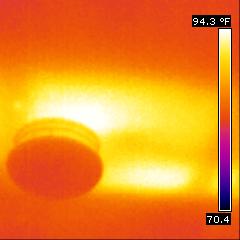Infrared cameras can be used during building inspections and energy audits to locate problems that can be found by viewing differences in temperature, which the camera sees as infrared radiation and presents as gradient colors. Every object warmer than absolute zero emits infrared radiation, which is invisible to the naked eye but is read by thermal imaging. Being able to view this allows inspectors to locate problems that would otherwise be more difficult and time-consuming to find. Understanding data that the camera displays is essential in utilizing IR technology correctly and to its fullest capabilities.
Thermal imaging during an inspection is basically used as a non-contact, temperature-measurement tool. Being able to measure temperature differences in this manner allows quick evaluation of large areas. It can also present some challenges to interpreting the data. A major factor to consider is that the amount of energy radiated by any object depends on the emissivity of the materials of which it is constructed or composed. This can lead to errors in interpreting the thermal images.
The emissivity of an object is dependent mainly on its surface qualities and the materials of its composition and construction. Non-metals and opaque objects with rough surfaces generally have higher emissivity. Pure, smooth, un-oxidized metals and objects with shiny, reflective surfaces have lower emissivity. Objects with low emissivity can still be examined through thermal imaging but special care should be taken to ensure that such images are interpreted correctly. For example, images of reflective surfaces may be affected by a hot light bulb elsewhere in the room. This could be misread as a temperature difference in the area being viewed. Taking into account the emissivity of objects being viewed, and scanning areas from different spots and angles can help ensure accurate interpretation of the thermal images. There are also many charts and guides available that show the relative levels of emissivity for different materials, which may be helpful for accurately interpreting and reporting the data.
